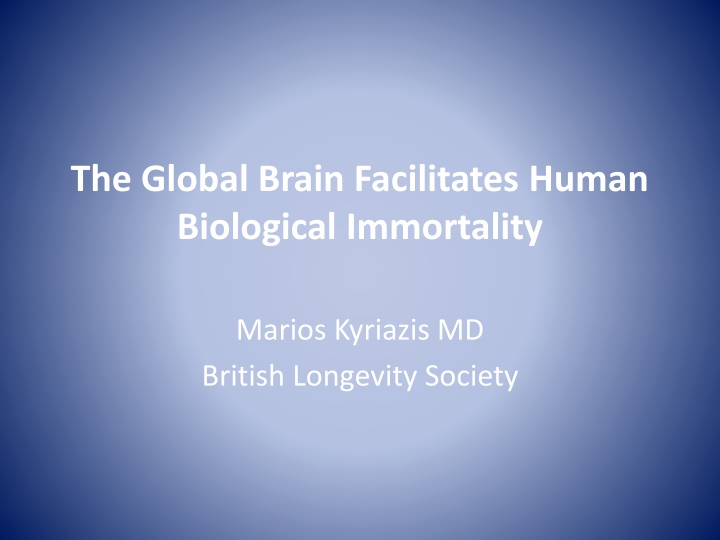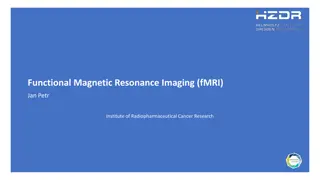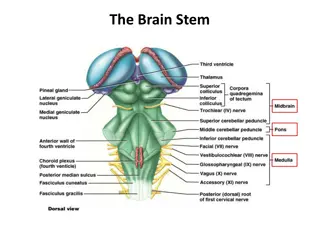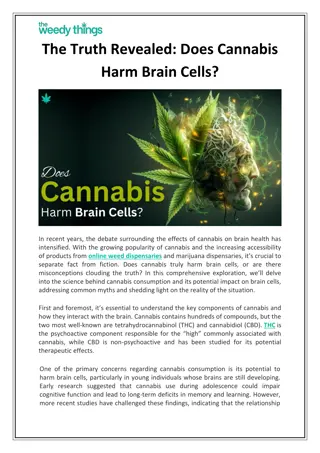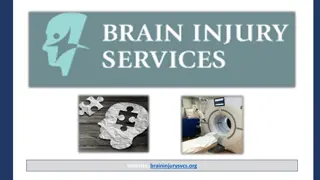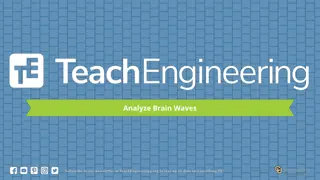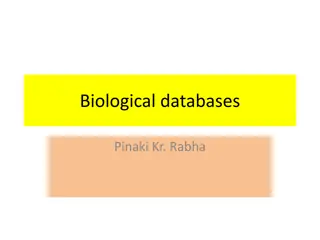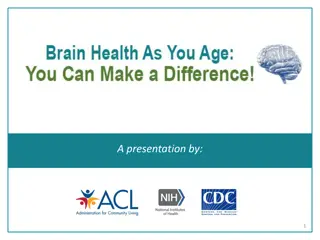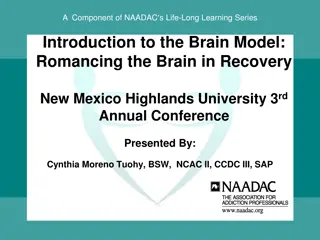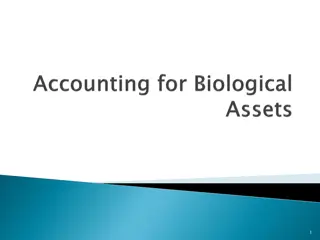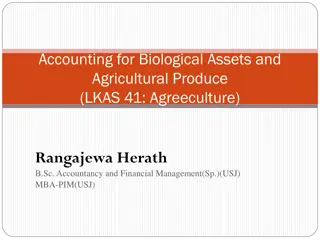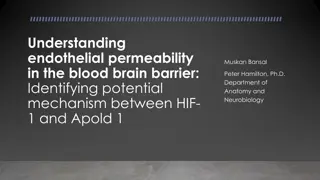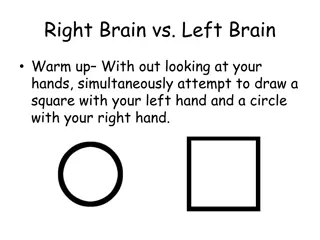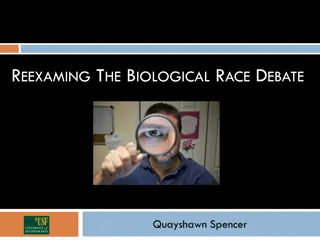The Global Brain Facilitating Human Biological Immortality
This content delves into the concept of Human Biological Immortality (HBI) facilitated by the Global Brain (GB) through increased complexity, discussing extreme lifespans, relevant terms, and futurology shock levels. It explores terminologies, hierarchies, and the potential elimination of aging to achieve indefinite lifespans, all presented with insightful visuals.
Download Presentation

Please find below an Image/Link to download the presentation.
The content on the website is provided AS IS for your information and personal use only. It may not be sold, licensed, or shared on other websites without obtaining consent from the author.If you encounter any issues during the download, it is possible that the publisher has removed the file from their server.
You are allowed to download the files provided on this website for personal or commercial use, subject to the condition that they are used lawfully. All files are the property of their respective owners.
The content on the website is provided AS IS for your information and personal use only. It may not be sold, licensed, or shared on other websites without obtaining consent from the author.
E N D
Presentation Transcript
The Global Brain Facilitates Human Biological Immortality Marios Kyriazis MD British Longevity Society
STRUCTURE What: HBI via the GB (and what it represents) How: via increased complexity (natural and artificial) Why: because of inexorable tendency from simpler to complex When: now and next 50 years Who: only those who engage, the rest is human plankton
Terminology * Academic research vs practical lay advice - for humans GB: distributed intelligence via interconnected humans plus internet/digital. Nothing else. (also, it represents achievement of high technological level, for first time)
Human Biological Immortality HBI: the rate of mortality as a function of age is zero (people will still die from other causes) Other terms: the abolition of ageing, or of involuntary death due to ageing Extreme Lifespans Indefinite Lifespans
Relevant Terms Environmental Enrichment: Externally-derived stimulation of the human brain (not other species) Hormesis Low-dose activation, high- dose inhibition
Futurology Shock Levels Eliezer Yudkowsky: to explore how people see themselves in accepting the next 50 years, and whether they are shocked by suggestions of how the future may look like. FSL 0: degree of change flat, minor developments, (most people) FSL 1: GB, living to 100, stem cells, hydrogen economy (conservative futurists) FSL 2: interstellar travel, alien cultures (science fiction) FSL 3: HBI, human-level AI, mind uploading (transhumanists, this discussion) FSL 4: singularity, (Matrioshka) Jupiter Brains, Alpha point computing, posthumanism, Apotheosis (Singularitarians) Yudkowsky: If there is a Shock Level 5, I m not sure I want to know about it!
Hierarchical Decomposition I will attempt to decompose the problem into more manageable modules, in order to study this issue in detail
IF: we eliminate the reason for ageing THEN: there will be no reason that denies non- ageing
Ageing does not happen by default There is an underlying reason When this reason is eliminated, there would be no reason why ageing needs to continue. The rate of damage exceeds the rate of repair =ageing (dysfunction) The rate of biological repair mechanisms tends to become progressively compromised with age, resulting in accumulation of damaged biological material that reduces useful function
The underlying cause of this is lack of energy resources energy resources (in the thermodynamical sense): limited resources that are used primarily for the repair of the germ cell in preference to that of the soma - these are being diverted, by Darwinian forces, from the somatic repair to the repair of the germ-line
Darwinian natural selection must increase complexity via any means But: human brain not developed enough So: has to allow selection via new offspring So: DNA must survive at the expense of the soma BUT if we increase energy available for somatic repair THEN soma will live (a topological phase transition)
The equaliser Any intentional attempt which improves the input of potential energy into an organic system makes the equalisation of the rate of damage vs repair more likely, and thus ultimately must result in retardation of ageing Ageing equals loss of energy and thus loss of complexity. Non-ageing is virtually stable energy and thus higher complexity. In this case, the reason for ageing is essentially removed. If there is no reason why ageing must happen, then it will not happen.
Biology Constructs Physics Destruct Or: Energy is a medium used by Biology in order to thwart Physics Entropy is a medium used by Physics in order to thwart Biology
Intentional Stance Biology is likely to increase potential energy, biological sophistication and redundancy Physical laws seek a state of lowest potential energy, minimal uncertainty and minimal entropy Biology and Physics are entangled in an eternal confrontation As it is hitherto impossible to change the laws of Physics, one way to tip the balance in our favour is to enhance Biology
Natural Selection Evolution by natural selection is the main obstacle to defeating ageing and thus bars HBI , because it requires the survival of the germ-line and thus diverts resources from somatic repair. If/when evolution by natural selection begins to weaken, the restriction of energy resources upon the soma will be eased, the soma will have improved resources for its repairs and thus it will live longer.
Ageing and Loss of Complexity Ageing is characterised by loss of complexity of biological systems (increased entropy over time). To counteract this, we must input more energy into the system in the form of cognitive stimulation, i.e. informational energy.
Cognitive Stimulation Random unintentional challenges and stimulation. This helps our brain function well. Against this, entropy increases, which eventually causes death because the degree of information input tends to zero with time, whereas entropy tends to infinity I propose to introduce another variable, the sum of intentional cognitive stimulation (i.e. intentional stimulation, special brain exercises, sense exercises, goal- oriented behaviour, seeking novelty and excellence etc.)
The Kyriazis Perpetual Equaliser ? ? Ai = ?=1 ?? + ?=1 ? ?? - ? Ai is the degree of activation ak is the sum of all individual random exposures to cognitive stimulation (a1+a2+a3+ an) ?=1 ?? is the total sum of all such sums of exposures where k ranges from 1 to n ? k is the sum of all individual intentional exposures to cognitive stimulation ( 1+ 2+ 3+ n) ?=1 ?? is the total sum of exposures where k ranges from 1 to n ? s is total entropy of the system ? is a variable - the degree of individual loss of intelligence as global intelligence increases Ai=0 is death(infinite entropy and zero cognition) Ai=k , is ideal, healthy (non-ageing) status Ai>k, is over-stimulation (unhealthy) Ai<k, under-stimulation (unhealthy)
The Need to Select Intelligence is the ability to make consistently correct selections from available choices. One has to be in a position that contains challenges which need resolving, and choices that need to be made. Routine, monotony and regularity do not account for increased need to select, whereas variability, irregularity and uncertainty maximise our need to select (and thus increase intelligence) and thus increase informational energy.
Information Information + Organisation Functionality Complexity
Shannon: entropy gain = information loss So: Loss of Information Loss of Functionality Loss of Complexity
Definition The noeme is the intellectual presence of someone within the GB
Noeme An active germ-line evolutionary replicator that can be copied and transmitted horizontally. Its vehicle is the human brain as part of the GB. It is copied from person to person/society, within the GB. It is copied by imitation and technologically assisted transfer (e.g. via the internet).
Noeme Sets a group of successful noemes (intellectual presences emanating from a group of human brains) can form a set (noeme set) that promotes the survival and success of all of the individual noemes within that set (e.g. ECCO intellect not ECCO people).
Symbiotic Relationship Genes and memes can enhance the presence of a noeme for example, by producing a genetically robust brain that has strong intellect and, through memes, consolidating its impact within society
Fitness Contribution The noeme competes with alternative forms and continues to evolve and adapt, sometimes being stable, sometimes changing or modifying itself. Noemes that do not contribute to the fitness of the GB are eventually eliminated. Those that enhance it, are retained and improved.
Opposition or .. All three can evolve in opposition Noemes that are not well integrated may be eliminated (and this will eliminate their human host through early ageing, thus death, thus the end of the gene/meme that defined them)
..Co-operation Or, a noeme defined by beneficial memes/genes can integrate well in the GB and evolve, and transmit their genes/memes to others
Qualities of an evolutionary replicator 1. Assimilation (the ability to infect a new host). This depends on the strength of the noeme. 2. Retention (it must remain in the memory of the subject/GB) 3. Expression (as a physical entity, e.g. cognitive information in the brain) 4. Transmission (through a physical medium, in this case through digital means)
Why Noemes? The behaviour of noemes can help us understand the behaviour and evolution of the GB. It makes it easier to define ourselves in a way that strengthens our intellectual presence in the world. By trying to enhance our cognition and intelligence we can become better integrated into the GB and so become a valuable part of it, forcing natural laws to operate in a way that prolongs our lifespan.
What constitutes a good stimulation or challenge A Positive Challenge is a condition that requires action (Francis Heylighen) because it represents an opportunity to be exploited. These can be: 1. Planned/anticipated, or 2. Unexpected/unintended
A Praxeological Approach Follow a program of planned positive challenges. The brain is forced to SELECT the best option An appropriate selection itself creates information (Shannon s reduction of uncertainty). Meaningful Information (knowledge, experience, wisdom, excellence), via expressive activation of appropriate brain mechanisms activates (increases the energy available to, or the potential energy of) biological patterns and agents that then improve repair and maintenance, thus non-ageing.
Entropy The generation of entropy over an average lifespan (around 80 years) was found to be in the region of 11,404kJ/K (Degrees kelvin). No entropy generation equals death. It is possible to estimate the specific entropy generation rate ?? over time and calculate the lifespan entropy generation per unit mass (?? is in kW/kg-K). ??? (t) dt ?? (t) = 0 Any reduction in the entropy production would therefore result/be associated with an increased lifespan (longer dt). Also, any increase of meaningful energy into the system would have the same result
Network Diameter and Spreading Activation using humans (nodes) instead of neurons (nodes) the network diameter is the shortest distance between two nodes a network of N nodes (such as brain/neuron OR GB/human) each with a number of links k, the network diameter ND is log(N)/log (k). So the ND will grow as the size of the networks increases, unless the number of links per node also increases (so we must increase our number of links to keep ND low it has to be low so that to ensure any positive feedback can be applied while the stimulus is still present, otherwise there will be no learning with good learning, functionality increases so it is useful to the GB).
Network Diameter and Spreading Activation In a network of N nodes (such as brain/neuron OR GB/human) each with a number of links k, the network diameter ND is log(N)/log (k) So the ND will grow as the size of the network increases, unless the number of links per node also increases (we must increase our number of links to keep ND low so that to ensure any positive feedback can be applied while the stimulus is still present, otherwise there will be no learning, leading to poor functionality of the GB
Network Diameter and Spreading Activation The distribution of links per node in nature follows a power law where the probability that a node has k links is proportional to ? ? (g is a positive number). It appears that the new nodes prefer to form links with other nodes that already have more links
Network Diameter and Spreading Activation Some circumstances where power law is not obeyed is when there is limited time for forming the links (such as in certain human interactions). So increasing the lifespan of the node, increases its ability to form links and power law is obeyed (it is more natural )
Spreading activation These links and nodes need to be activated and pass the activation to other nodes. The strength of the link (via synapses and/or via digital connection) will determine the activation potential. This is represented by A(t+1)=M x A(t) where A(t) is the activation of a node at time t M is the matrix denoting the weight of the links from one node to another A(t+1) is the activation of the node at the next time step. The higher the nodal activation, the more relevant the role of that node will be within the (brain/GB)
Biological amplification What happens during stimulation (arrival of new information)? Photonic recycling in cell surface interactions after dissipation of energetic states Ligand-receptor associations alter the conformation of the extracellular portion of intramembranous proteins and this change is transmitted to the cytoplasm by the transmembranous helical segments via non-linear vibrations of proteins and generation of soliton waves
Biological Amplification Photon-photon interactions induce molecular vibrations responsible for bioamplification of weak signals described by: ??2= BvLq m is the mass of the molecule c is the velocity of the electromagnetic field B is the magnetic flux density v is the velocity of the carrier in which the particle exists L is its dimension, and q is a unit charge.
Biological Amplification After activation of the cell with the new information, the cell must respond. Example: in the primary visual cortex, V1 neurons can be activated to fire action potentials. The neuron assesses spatial frequency, orientation, motion, direction and speed.
The responses of V1 neurons consist of tiled sets of selective spatiotemporal filters. In the spatial domain, the functioning of V1 is similar to many local, complex Fourier transforms ??cos??? + ??sin??? ? ? = ?0+ ? ? ?=1
How to choose an ideal degree of challenge Csikszentmihalyi's concept of flow . How a challenge that matches one s skills and abilities causes well-being. If the challenge is over one s ability then it causes anxiety. If it is below, it causes boredom. Blascovich's challenge versus threat . A challenge is a situation that matches our resources to deal with it. A threat is when our resources are below what is necessary. If a mental challenge causes excessive stress or anxiety, it is unlikely to be beneficial in ageing. If it is of such a low intensity that causes boredom, then it will not be beneficial either.
Erwan Le Corre The variation between a low and a high level challenge is likely to mobilize biological resources and activate defence mechanisms that can ultimately increase biological redundancy and improved damage repair rates. This implies that there must be a continuous variation of challenging stimuli, without ever reaching a stage of exhaustion (in this case, mental exhaustion).
Environmental Enrichment Enrichment aided by technological inputs such as digital assistants in a context of societal and cultural progression. This is a novel approach to the issue of longevity, as it does not merely refer to achieving a healthy lifespan but also to actually force the existing model of human evolution to transit to a more sophisticated level. The continual informational cognitive input may have a positive effect on epigenetic DNA changes which could then act in a way to up-regulate certain anti-ageing genes. This may be augmented by environmental enrichment, and increased use of technology, such as digital assistants, nanotechnology and synthetic biology.
